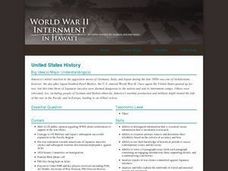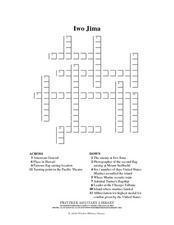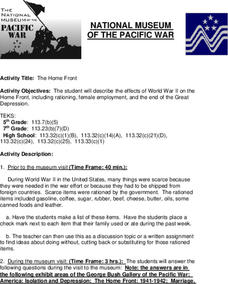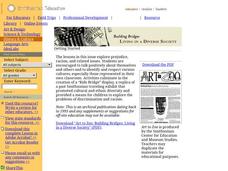EngageNY
Building Background Knowledge: “War in the Pacific,” Part 2
Who did what? Readers take a closer look at War in the Pacific to determine each country's actions. As they read, scholars underline American actions in one color and actions of Japan in another. They then begin completing Pearl Harbor...
EngageNY
Launching The Performance Task: Building Background Knowledge: “War in the Pacific,” Part 1
It's all about a bit of give and take. Scholars silently read War in the Pacific and circle any unfamiliar words. Using context clues, they write each word on a strip of paper along with the inferred definition. After looking the word up...
EngageNY
Connecting Ideas in Primary and Secondary Sources: What Led to the Attack on Pearl Harbor?
Let's make some sense of those thoughts! Scholars continue thinking about the different perspectives on Pearl Harbor. They analyze quotes from War in the Pacific, Day of Infamy, and Fourteen-Part Message. Readers tape each quote to chart...
Roy Rosenzweig Center for History and New Media
War and Poetry
A band of brothers or the Devil's agents? Nobel warriors freeing the oppressed or mercenaries working for the military/industrial complex? Groups examine poems from the Civil War, World War I, and World War II to determine the poets'...
Constitutional Rights Foundation
The Cold War: How Did It Start? How Did It End?
What is the difference between a Cold War and a Hot War? Scholars research the beginning of the Cold War. They analyze diary entries as well as excerpts from various events during the 45-year standoff. To finish, they prepare final...
US National Archives
WWII: The Pacific 1939-45 – Japan and the Atom Bomb
Though the scientists who developed the atom bomb did not believe it should be used to end World War II, American President Harry S. Truman and British Prime Minister Winston Churchill were of like mind in their decision to drop the bomb...
Curated OER
World War II: Internment in Hawaii
Students examine world history by writing an essay in class. In this World War II lesson, students identify the attack on Pearl Harbor, the response from the U.S and the effect it had on Japanese-Americans. Students define Japanese...
Polk County Public Schools
The Blame Game for the Loss at Pearl Harbor
Known as the day that will live in infamy, the attack on Pearl Harbor in 1941 was a shock to all. But why was the United States unprepared on that December morning? Study a series of primary sources in a document-based question that...
Curated OER
Iwo Jima
Here is a crossword puzzle on some of the more important aspects of the Iwo Jima conflict during World War II. There are four words to compose going across, and eight words going down. An answer key is on page two of the worksheet. Good...
Curated OER
World War II
Fifth graders examine primary sources to explore the events leading to World War II. In this World War II lesson, 5th graders develop questions and research answers from information found in primary documents. Students view a video...
Curated OER
A Boy at War: A novel about Pearl Harbor by Harry Mazer
This A Boy At War PowerPoint introduces the historical context of the novel and information about the novel's author. Facts and trivia about Pearl Harbor that are relevant to the novel's plot are reviewed. Historical photos and a map of...
Scholastic
Dear Miss Breed
This compelling plan based on the letters in the book Dear Miss Breed engages readers in learning what it was like for Japanese Americans following the attacks at Pearl Harbor. After reading the letters, young scholars will...
Curated OER
French and Indian War
Seventh graders complete a unit on the French and Indian War. They conduct an Internet document search and use what they find to complete a document based essay about the war.
Curated OER
Letters from the Japanese American Internment
Students explore the concept of Japanese internment. In this Japanese internment activity, students examine primary sources that enable them to discover what internment camp life was like and its implications, Students write their...
Curated OER
Smithsonian Asian Pacific American Lesson: Immigration
Many of your class members will have heard of Executive Order 9066 and the Japanese internment camps of World War II. Some may even recognize the terms “Issei” and “Nisei,” but few will have heard of Enemy Alien Hearing Boards, of the...
Curated OER
"ART ZOO 'Blacks in the Westward Movement', 'What Can You Do with a Portrait', and 'Of Beetles, Worms, and Leaves of Grass'"
Students study black history, examine portraits and portrait making and create their own portraits, and investigate their natural environment. This humanities lesson provides a text that can be used to teach lessons in black...
Oklahoma State Department of Education
Narrative Prompt
Reading about history is nothing like experiencing it firsthand. Encourage your eighth graders to do the next best thing with a historical narrative prompt, in which they describe the experience of a first-time traveler on the...
Core Knowledge Foundation
Unit 8: Code Talker by Joseph Bruchac Teacher Guide
Joseph Bruchac's Code Talker tells the remarkable story of Navajo Marines' role in battles of the Pacific Theater during World War II. As scholars read the novel, they also engage in activities that expand their knowledge of Navajo...
Curated OER
Breaching the Gulf Between Cultures
Students explore the dynamics, the challenges, and the rewards of adjusting to a new culture through the reading of "Help! My Father is Coming" and "The Visit to Vijay's". For this social culture lesson, students carousel brainstorm...
Curated OER
Encountering Very Different Ways of Life
Students explore the concept of crossing cultures through reading the stories "Help! My Father is Coming!" and "The Visit to Vijay's." In this culture lesson, students predict what will happen next in the stories. Students discuss the...
Curated OER
Entering the World Stage
For this American imperialism worksheet, students review a chapter as they define 5 vocabulary terms in their own words, eliminate 4 false statements, and identify 2 themes from this era of growth and challenge in America.
Curated OER
The Home Front
Students describe the effects of World War II on the Home Front, including rationing, female employment, and the end of the Great Depression. They interview someone who was at home during World War II and ask them how the war affected...
Curated OER
Plants and Animals: Partners in Pollination
Students identify the plant parts and bee structures that are involved in pollination. They simulate pollination in a group activity and process the information.
Curated OER
Building Bridges: Living in a Diverse Society
Students participate in various activities that help them build esteem, and explore racism. In this multicultural lesson plan, Students increase their awareness of, and appreciation for, cultural differences and similarities. This...























